Tharp's Thoughts Weekly Newsletter
-
Article: Hedging Your Unconscious All-In Currency Trade by Gabriel Grammatidis
-
Workshops: Forex and Trading in a Bear Market this May!
-
Tip: Where Next for the S&P 500? by D. R. Barton, Jr.
-
Mailbag: A Dialogue With A Part, by Suhas, A Grateful Student
3 Back-to-Back Opportunities to Learn from the Best!
Forex Trading, Live Forex Trading, Trading in a Bear Market
Forex Trading and Live Forex Trading with instructor Gabriel Grammatidis
Have you seen the headlines about currency rate fluctuations?
Does trading Forex seem different enough from your current market that you've stayed away from it?
Join us for these two workshops and leave prepared to trade the system right away.
"The best aspect of the course was the knowledgeable, accessible instructor."—Harold G, Las Vegas, NV
"I am a Forex trader, and I thought Gabriel did an excellent job introducing everyone to Forex."—Anonymous, Melbourne, Australia
“Very high quality documentation and presentation technology… I didn’t expect I would learn as much as I did.”—Robert Allen, Fountain Hills, AZ.
Trading in a Bear Market with instructor Mark McDowell
In our newest 3-day workshop you will:
| • |
|
Study in depth the concept of a bear market. |
| • |
|
Learn what a bear market truly is and learn several ways to define and measure the bear market type. |
| • |
|
Know when a bear market type might be starting and how to know when it might end. |
| • |
|
Learn 5 trading strategies suited for bear market conditions. |
| • |
|
Learn how options can be especially useful for bear market types. |
To register or to see the full workshop schedule, click here.
Article
 Hedging Your Unconscious All-In Currency Trade
Hedging Your Unconscious All-In Currency Trade
by Gabriel Grammatidis
View on-line to resolve formatting problems
You are trading currencies. You might not have realized that but you are. I don’t mean that you necessarily have an FX account, actively trade pairs and watch pips. Actually, you may think of yourself as an equities or futures trader but you do, however, trade currencies. What do I mean? Your chosen or domestic currency has a relative value in the global marketplace and if it’s losing value against other currencies, you are long on a major position with a declining price. Have you ever gone all-in before? If you don’t hedge your currency somehow, you are all-in in your present currency. Paying attention to long term currency trends and knowing how to make some longer term position trades can benefit your trading results greatly. But how do you do that?
Trading FX Systems – Fractally
You have probably heard the market belief that “prices are fractal in nature”. This means that the same principles, techniques and system rules can be applied to any timeframe – be that the 15 minute bars, daily bars or even the monthly chart. I have this belief and I show how it applies across all of the systems I teach in the upcoming FX workshop. In my experience, these systems are at least equally reliable on higher timeframes as they are on lower timeframes.
Below, you can see a monthly bar chart that refers to a long-term trade setup we found during the last Live FX workshop in October, 2014 (see the related Rich Man’s Panic). System 1 (Busted Breakout) triggered the entry signal for a position in the GBPAUD pair on the monthly chart in mid-October of last year. Over the last 6 months this trade has generated a nice profit so far of around 8% respectively or 1400 pips. The position has reached better than break-even in its R multiple and is still open running towards the target zone at 2.4.
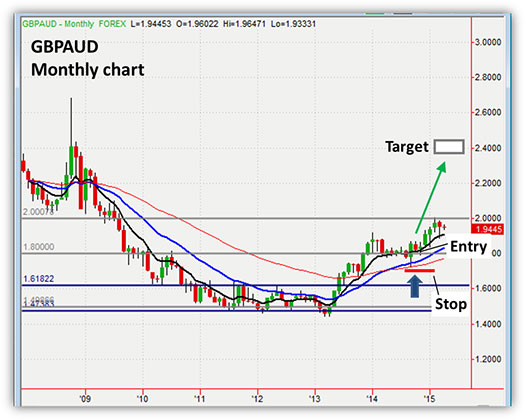
Managing Your FX Exposure
Please be aware that whether you trade stocks or bonds, you always face Foreign exchange exposure. If you trade US stocks you are actually long the USD. By the same reasoning, the SNB unpeg left investors that owned Swiss stocks with an enormous benefit from the appreciation of the Swiss Franc alone. If you have been long Japanese stocks, you might have found nice gains in your stocks — until you consider how the Yen has devalued against the USD – which may have erased any gains in your equity positions.
For most people, currency moves and fluctuations just seem to happen outside of their awareness. Currency moves may even appear random to casual observers. Are long-term currency moves really random? I don’t believe so for one moment. Thinking about and acting on which currencies might appreciate or depreciate in the coming period will have a positive impact on the overall return for your portfolio. As well, you might want to seriously consider how to hedge longer term positions that are exposed to a depreciating currency.
In this respect, have you ever thought about longer term trading currencies with your retirement account? Please note that Americans are actually able to trade FX within their IRA accounts or 401K accounts and many brokers allow you to do exactly this.
Higher Timeframe Trade Signals
Being fractal in nature, the FX market allows a number of systems (all of the ones I teach) to be applied in the very same way on higher timeframes than the timeframe for which the system was originally intended to work. Let’s look at several case studies for long-term FX entry signals of the GBPUSD pair generated by the Busted Breakout system in the daily and monthly charts. First, here’s a daily chart of the GBPUSD pair from mid 2013 – mid 2014 with two setups and entry signals:
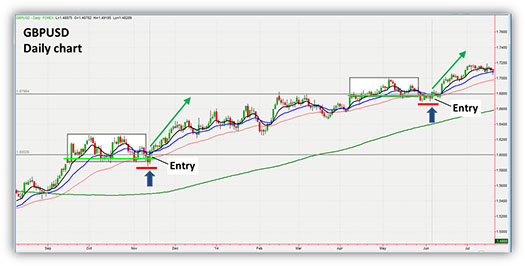
Both signals occurred in a well established uptrend and represented excellent trading opportunities for riding the trend over several weeks/months. Every new entry signal offers an opportunity to add size to an existing position which allows you to build a large, long-term position in a strong trending FX pair.
Now, let’s have a look at the current GBPUSD monthly bar chart in which you can see the upward trend from the chart above in perspective of a longer timeframe. The system works very similarly with monthly bars as is does with daily bars. In this case, however, the trend reversed late last year and as you can see below, the system generated a short entry signal late last year. The target for the pair is at par level which should be achieved within the next 12 to 18 months. This trade offers a potential gain of around 30% or 5,000 pips.
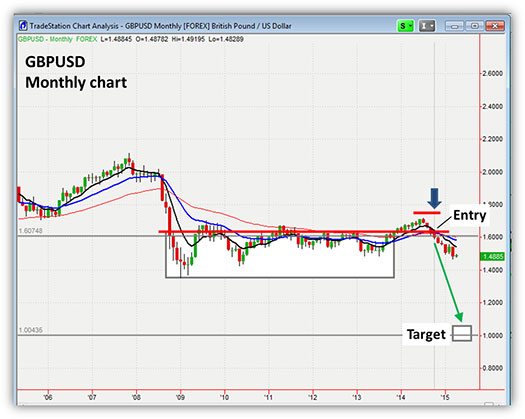
Suitable Instruments for Long-Term FX Positions
You might wonder about the best way to trade higher timeframes for FX. You might also have some concerns holding a position over a long period of time in a margined instrument such as a currency future or FX spot. As mentioned in an earlier article (see Practical Swissy Lessons) Forex traders have the benefit of being able to choose from a wide variety of FX instruments. For trading longer-term using daily, weekly or even monthly charts, I would recommend using standardized and liquid instruments namely currency ETFs (leveraged or unleveraged) or currency options. Please note: you cannot lose more than your invested capital on the options and no more than your capital plus equity margin for ETFs (note — retirement accounts typically do not provide margin). One advantage of trading currency options is that you can benefit from the increase in price and also from the expansion in volatility — which is typical for Busted Breakout system trades.
Remember, you already hold a large currency position whether you realized it or not. Learn to benefit from the trending currencies as they are likely to trend for the foreseeable future!
Good trading,
Gabriel Grammatidis
If you are interested in learning more about trading Forex or investing in currencies, read Gabriel’s article The Swissy Unpeg, Some Practical Lessons. You can also find a good list of resources and watch his videos at https://vanktharp.com/workshops/forex.asp
About the Author: Gabriel Grammatidis is a successful full-time trader and graduate of the Super Trader program. He has extensive experience trading Forex and shares his knowledge at his Forex and Live Forex Trading workshops, held regularly at VTI. Gabriel can be reached at gabriel "at" vantharp.com.
Workshops
Combo Discounts available for all back-to-back workshops!
See our workshop page for details.
Trading Tip

Two Months in an 80 Point Box—
Where Next for the S&P 500?
by D. R. Barton, Jr.
View on-line to resolve formatting problems
The bears can’t get anything going. But then again, neither can the bulls. And so we have this sideways market for the last two months in a pretty darn tight 80 point channel.
Don’t get me wrong — there have been plenty of big one day direction swings — and some of them are pretty wild as intraday traders can attest. The trader that I know best calls this a “pogo stick market”.
If you had to pick who is winning, I’d have to say the bulls, but just by a hair. That’s only because we’re hugging the top of the page and the bears can’t get this market to move more than 4% off the all-time highs. This chart shows that 80 point channel quite clearly in the gray box - which dates back to February 5th.
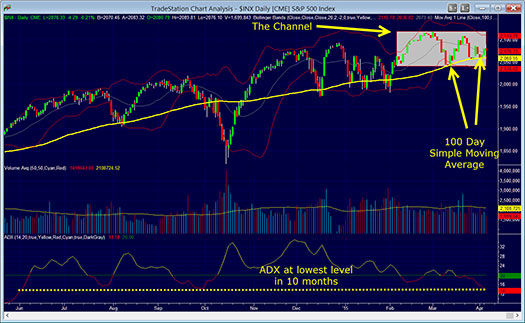
You can also see the very important 100 day simple moving average still holding as a very important support level. The very bottom line (under the price chart) shows the Average Directions Index (ADX) indicator that calculates the 14 day trendiness (directional movement) of the instrument. The S&P’s trendiness has been declining since late last year and you see that we’re now at the lowest levels seen since last June!
It’s Not Just the S&P 500 That’s Going Sideways (Cool Chart Alert)
I haven’t fed my appetite for a really cool chart on these pages for some time so let’s fix that. The research-crazy folks over at Bespoke sent out this interesting, useful and yes, just plain cool graphic today.
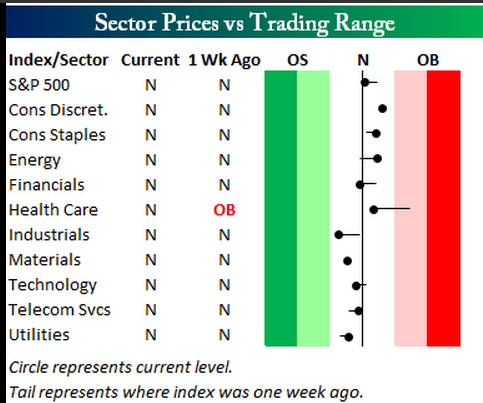
The chart uses ETFs as a proxy for the major stock market sectors to show how close each sector’s price level is to a moving average. The black dot represents each ETF’s closing price in relation to a 2% band around its 50 day simple moving average (50 SMA). This week, the S&P 500 and the 10 constituent sectors that make it up were all less than 2 percent away from their respective 50 SMAs. And only healthcare moved outside of that range in the last week.
Since we are looking at relationships to the 50 SMA, I thought I’d take a look at an indicator that gives us some insight into both the technical and the sentiment pictures for the broader market. This is stockcharts.com’s line graph showing the percent of the S&P 500 stocks trading above their 50 SMA.
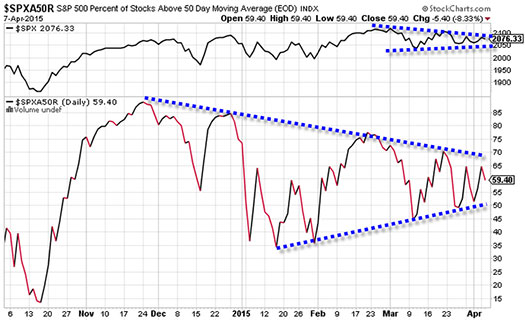
You can see that as the volatility of the S&P closing price contracts (solid black line, top graph), so does the movement of stocks popping above their 50 SMAs (lower black & red line).
So we are in a serious range contraction with a market that is the most directionless that it has been since last June. One thing we know for sure — range contractions are followed by range expansions. This sideways wandering will end — and probably soon.
As I said two weeks ago, the 100 SMA continues to be a major line in the sand — a close or two below that level will most likely lead to more downside action. The longer, however, that the 100 SMA holds as support, the greater the likelihood is that we will bust out to the upside from this current sideways malaise.
As always, I welcome your thoughts and comments — please send them to drbarton “at” vantharp.com. I always enjoy hearing from you!
Great Trading,
D. R.
About the Author: A passion for the systematic approach to the markets and lifelong love of teaching and learning have propelled D.R. Barton, Jr. to the top of the investment and trading arena. He is a regularly featured analyst on Fox Business’ Varney & Co. TV show (catch him most Thursdays between 12:30 and 12:45), on Bloomberg Radio Taking Stock and MarketWatch’s Money Life Show. He is also a frequent guest analyst on CNBC’s Closing Bell, WTOP News Radio in Washington, D.C., and has been a guest on China Central Television - America and Canada’s Business News Network. His articles have appeared on SmartMoney.com MarketWatch.com and Financial Advisor magazine. You may contact D.R. at "drbarton" at "vantharp.com".
Mailbag
A Dialogue With A Part
Hi Van,
First, let me thank you from the bottom of my heart for the amazing work that you have been doing for traders. I can't thank you enough.
I'm currently going through the Peak Performance Home Study Course (an unfathomable mine of gems really). I have now come to fully realize that self-esteem (I scored 24) is probably the biggest issue I have that I know of so far. I have been working on the guidelines you provided in the course and just wanted to share that I found the part about identification and negotiation process greatly useful for dealing with, or rather understanding, self-esteem.
I have been feeling bad about the fact that I have self-esteem issues. Now that I know it, I see it pop up frequently. That used to make me uncomfortable and feel bad about myself but not any longer. So, I identified the part of me that probably is responsible for my self-esteem which is a Winner (or I hate Losing) Part.
Winner (or I-Hate-Losing) Part
Behavior:
It feels bad when I lose in Trading, Tennis or anything else. It makes me feel inferior when someone does better than me, especially when in my judgment I consider my skills and abilities better than them. When comparing myself with others, I have a strong desire to win and be appreciated I feel better because it has been programmed that I'm good only if I win. It warns me through fear when in-the-moment price action on the chart looks unfavorable, though it's valid as per my set-up rules and thus creates conflict.
Good Intentions:
I feel that I should win. I should be better and the best at what I do and thus prove my goodness and feel good about it. So this part tracks the time and measures how I'm doing with winning/losing. It gives me feedback when it sees that I'm about to lose through tension and fear. It provides me motivation to do better next time and excel at what I do.
My Internal Dialogue and New Deal with this part:
It's only now that I've realized your good intentions for me. I can now appreciate the importance and significance of the role you have played so far in my life. It's only because of you that I have worked hard at getting better at things I cared for and have been able to achieve so many things so far in my life that I can be proud of. You have never failed to track my performance, give me feedback and motivate me to get better, despite me not really understanding you that way. I now really understand what you have been doing for me and am immensely thankful to you and I love you! Hey, I've now decided to measure my self-worth by how committed I am to achieving what I want and how happy I am in-the-moment. I don't have any historic value for my self-worth; it's transient and in-the-moment (based on my new identity belief). I now really need your help to track and measure me on my commitment and happiness levels and to give me feedback on the same and motivate me to do better on these fronts. Would you do this for me, as I know no one else that can do these functions as you have been doing relentlessly and unfailingly?
With this, my part seems to have agreed to take on the new role and it's happy that I've now understood it for what it is. I felt such a relief after this process and really felt happy and this wasn't actually difficult at all!
Actually the proof of how effective this has been is in the following fact. One of your suggestions in the course to deal with self-esteem issues is to love myself and behave with myself the way I would with someone whom I love the most. Honestly, I really found it difficult to love myself unconditionally even after trying many times. But now having identified this and other parts, understanding them and having had a dialogue with them I feel so much better and at peace with who I am. The idea of loving myself seems to be very natural.
This is what I was really excited to share with you. Thanks for your time, and again a big thank you for everything.
Thanks,
Suhas
Matrix Contest
 Enter the Matrix Contest Enter the Matrix Contest
for a chance to win a free workshop!
We want to hear about the one most profound insight that you got from reading Van's new book, Trading Beyond the Matrix, and how it has impacted your life. If you would like to enter, send an email to [email protected].
If you haven't purchased Trading Beyond the Matrix yet, click here.
For more information about the contest, click here.
Ask Van...
Everything we do here at the Van Tharp Institute is focused on helping you improve as a trader and investor. Consequently, we love to get your feedback, both positive and negative!
Send comments or ask Van a question by clicking here.
Also, Click here to take our quick, 6-question survey.
Back to Top
Contact Us
Email us at [email protected]
The Van Tharp Institute does not support spamming in any way, shape or form. This is a subscription based newsletter.
To change your e-mail Address, e-mail us at [email protected].
To stop your subscription, click on the "unsubscribe" link at the bottom left-hand corner of this email.
How are we doing? Give us your feedback! Click here to take our quick survey.
Call us at: 800-385-4486 * 919-466-0043 * Fax 919-466-0408
SQN® and the System Quality Number® are registered trademarks of the Van Tharp Institute and the International Institute of Trading Mastery, Inc.
Be sure to check us out on Facebook and Twitter!
 
Back to Top
|
|
April 08, 2015 #728

Our Mission
Van's Top-Twelve Favorite Trading Books
Yahoo and Gmail Users:
Viewing on-line eliminates spacing, and formatting problems that may be unique to your email program.

Ongoing Contest: Learn how you could win a $50 coupon and a grand prize of a free workshop!

"I base my long-term, monthly rebalancing [core] strategies on research into relative strength and momentum as it relates to broad asset classes."-K Long

A Must Read for All Traders
Super Trader
How are we doing?
Give us your feedback!
Click here to take our quick survey.
From our reader survey...
"I think the newsletter is extremely generous and it is a resource I utilize constantly. I have saved every single one since I first subscribed."
Trouble viewing this issue?
View Online. »
Tharp Concepts Explained...
-
Trading Psychology
-
System Development
-
Risk and R-Multiples
-
Position Sizing
-
Expectancy
-
Business Planning
Learn the concepts...
Read what Van says about the mission of his training institute.
The Position Sizing Game Version 4.0
Have you figured out yet how to pick the right stocks? Are you still looking for a high win-rate trading system? When you’re ready to get serious about your trader education, download the Position Sizing Game to learn some true fundamentals of trading success. Learn more.
To Download for Free or Upgrade Click Here

Download the first three levels of Version 4.0 for free:
Register now. »
Trouble viewing this issue?
View Online. »

Dr. Tharp is on Facebook

Follow Van through
Twitter »

Check out our home study materials, e-learning courses, and best-selling books.
Click here for products and pricing
What Kind of Trader Are You? Click below to take the test.
Tharp Trader Test
Back to Top

Introduction to Position Sizing™ Strategies
E-Learning Course
Perfect for auditory/visual learners who learn more effectively from an instructional format that is full of interactive features!
Only $149
Learn More
Buy Now
SQN® and the System Quality Number® are registered trademarks of the Van Tharp Institute
|